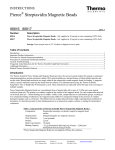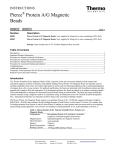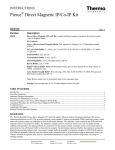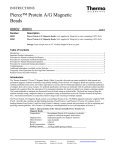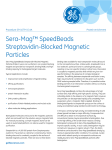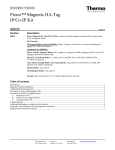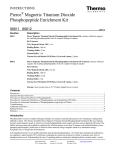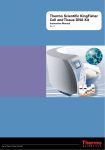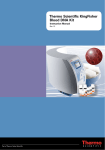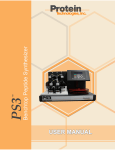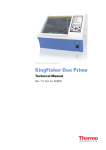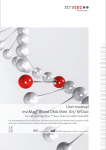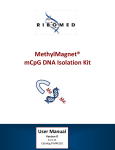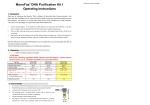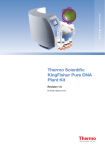Download Pierce Glutathione Magnetic Beads
Transcript
INSTRUCTIONS Pierce® Glutathione Magnetic Beads 88821 88822 2076.1 Number Description 88821 Pierce Glutathione Magnetic Beads, 4 ml, supplied as a 25% slurry in 20% ethanol 88822 Pierce Glutathione Magnetic Beads, 20 ml, supplied as a 25% slurry in 20% ethanol Storage: Upon receipt store at 4°C. Products are shipped with an ice pack. Introduction The Thermo Scientific Pierce Glutathione Magnetic Beads provide a fast and convenient method for manual or automated purification of glutathione-S-transferase- (GST) fusion proteins from a bacteria, yeast or mammalian crude cell lysate. These beads are simply added to a lysate containing the GST-fusion protein. After incubation, non-bound proteins are removed by washing, and the GST-fusion proteins are eluted using reduced glutathione. A magnetic stand is used for manual processing. For automated processing, the Thermo Scientific KingFisher® Flex or KingFisher 96 Instrument is used. These instruments are especially useful for large-scale screening of multiple samples. Table 1. Characteristics of Thermo Scientific Pierce Glutathione Magnetic Beads. Composition: iron oxide particles with reduced glutathione (GSH) covalently attached to the surface and encapsulated by crosslinked agarose Magnetization: Superparamagnetic (no magnetic memory) Mean Diameter: 1-10 μm Concentration: 25% slurry (based on volume) in 20% ethanol Binding Capacity: 5-10 mg of GST fusion protein per 1 ml of settled beads (i.e., 4 ml of 25% slurry) Important Product Information • Do not freeze, dry or centrifuge the Pierce Magnetic Beads, which causes bead aggregation and loss of binding activity. • Cell lysates can be prepared from a variety of methods, including Thermo Scientific Cell Lysis Reagents (e.g., B-PER® Bacterial Protein Extraction Reagent, Product No. 78243, 78248; Y-PER® PLUS Dialyzable Yeast Protein Extraction Reagent, Product No. 78999; M-PER® Mammalian Protein Extraction Reagent, Product No. 78501), sonication and French press. • For best results, perform a small-scale test extraction to estimate the expression level and determine the solubility of the GST-fusion protein. After lysis, centrifuge and analyze supernatant by SDS-PAGE. Only soluble protein extracts that are clarified and have no protein particulates are successfully processed with the Pierce Glutathione Magnetic Beads. • Inclusion bodies of GST-fusion proteins that have been solubilized in urea or guanidine must be dialyzed to remove the denaturant(s) and refold the protein before affinity purification with Pierce Glutathione Magnetic Beads. (GST must be functional to bind glutathione.) • To minimize protein degradation, include protease inhibitors (e.g., Thermo Scientific Halt Protease Inhibitor Single-Use Cocktail EDTA-free, Product No. 78425) in cell lysate preparations. • Boiling the beads in SDS-PAGE sample buffer is acceptable for single-use applications. Boiling will cause bead aggregation and loss of binding activity. Pierce Biotechnology PO Box 117 (815) 968-0747 3747 N. Meridian Road Rockford, lL 61105 USA (815) 968-7316 fax www.thermo.com/pierce Procedure for Manual GST-Fusion Protein Purification from Bacteria A. Additional Materials Required • 1.5 ml microcentrifuge tubes • Bacterial cell lysate • Binding/Wash Buffer: 125 mM Tris, 150 mM NaCl, pH 8.0 • Elution Buffer: Immediately before use prepare 50 mM reduced glutathione (Product No. 78259) in Binding/Wash Buffer • Magnetic stand (e.g., Thermo Scientific MagnaBind Magnet for 6 × 1.5 ml Microcentrifuge Tubes, Product No. 21359) B. Pre-wash the Pierce Glutathione Magnetic Beads Note: To ensure bead homogeneity, mix the vial thoroughly before use by repeated inversion, gentle vortexing or rotating platform. 1. Place 100 μl of Pierce Glutathione Magnetic Beads into a 1.5 ml microcentrifuge tube. 2. Place the tube into a magnetic stand to collect the beads against the side of the tube. Remove and discard the supernatant. 3. Add 300 μl of Binding/Wash Buffer to the tube. Invert the tube several times or vortex gently to mix. Collect the beads with a magnetic stand, then remove and discard the supernatant. Repeat this step twice. Note: Do not allow the beads to dry. If necessary, store the beads in Binding/Wash buffer before proceeding with purification protocol. C. GST-Fusion Protein Purification from a Bacterial Cell Lysate Note: The procedure is for 50 μl of cell lysate prepared from 1 ml of bacterial culture. Adjust the buffer and bead quantities as needed for the specific lysate. 1. Dilute 50 μl of bacterial cell lysate with 250 μl of Binding/Wash Buffer. 2. Add diluted lysate to the tube containing pre-washed magnetic beads from above and gently invert or vortex to mix. 3. Incubate the samples at room temperature with mixing (e.g., on a rocking platform) for 1 hour. Alternatively, incubate at 4˚C. 4. Collect the beads with a magnetic stand and remove the supernatant. If desired, save the supernatant for analysis. 5. Add 300 μl of Binding/Wash Buffer to the tube, mix well, collect the beads with a magnetic stand and discard the supernatant. Repeat this wash twice. 6. Add 200 μl of Elution Buffer to the tube, mix well and incubate 5 minutes at room temperature with mixing. Note: If desired, smaller elution volumes can be used. Note: If the elution is not complete, perform an additional 5 minute elution. Combine the eluates from multiple elutions. Pierce Biotechnology PO Box 117 (815) 968-0747 3747 N. Meridian Road Rockford, lL 61105 USA (815) 968-7316 fax 2 www.thermo.com/pierce Procedure for Automated GST-Fusion Protein Purification from Bacteria A. Additional Materials Required • KingFisher Flex with 96 deep well head (Product No. 5400630) or KingFisher 96 (Product No. 5400500) • Microtiter Deep Well 96 Plate, V-bottom, polypropylene (100-1,000 μl; Product No. 95040450) • KingFisher Flex 96 tip comb for Deep Well magnets (Product No. 97002534) • Bacterial Cell Lysate • Binding/Wash Buffer: 125 mM Tris, 150 mM NaCl, pH 8.0 • Elution Buffer: Immediately before use prepare 50 mM reduced glutathione (Product No. 78259) in Binding/Wash Buffer B. Preparation of the KingFisher Instrument and Plate Set-up Note: The following protocols are designed for general use with the KingFisher Flex or KingFisher 96. The protocol can be modified according to customer needs using the BindIt™ Software provided with the instrument. 1. Download the “GST-Fusion Protein Purification” protocol from the web site (www.thermo.com/kingfisher) into the BindIt Software on an external computer. 2. Transfer the protocol to the KingFisher Flex or KingFisher 96 from an external computer. See the BindIt Software User Manual for detailed instructions on importing protocols. 3. Set up the plates according to Table 2. Table 2. Pipetting instructions for the automated purification protocol. Plate # Plate Name Plate Type Content Glutathione beads 1 Beads Microtiter Deep Well 96 Plate Binding/Wash Buffer 2 Bead Prewash Microtiter Deep Well 96 Plate 3 Protein Sample Microtiter Deep Well 96 Plate 4 Wash 1 5 Volume 100 µl 100 µl Binding/Wash Buffer 1,000 µl Bacterial Cell Lysate 50 µl Binding/Wash Buffer 250 µl Microtiter Deep Well 96 Plate Binding/Wash Buffer 300 µl Wash 2 Microtiter Deep Well 96 Plate Binding/Wash Buffer 300 µl 6 Wash 3 Microtiter Deep Well 96 Plate Binding/Wash Buffer 300 µl 7 Elution Microtiter Deep Well 96 Plate Elution Buffer 200 µl 8 Tip Plate Microtiter Deep Well 96 Plate KingFisher Flex 96 tip comb for Deep Well magnets - Notes: • If using less than 96 wells, fill the same wells in each plate. For example, if using wells A1 through A12, use these same wells in all plates. • To ensure bead homogeneity, mix the vial thoroughly by repeated inversion, gentle vortexing or rotating platform before adding the beads to Plate 1. • Combine the Tip Comb with a Deep Well 96 plate. See the instrument user manual for detailed instructions. C. Executing the GST-Fusion Protein Purification Protocol on the KingFisher Flex or KingFisher 96 1. Select the protocol using the arrow keys in the instrument keypad and press Start. See the instrument user manual for detailed information. 2. Slide open the door of the instrument’s protective cover. Load the plates into the instrument according to the protocol request, placing each plate in the same orientation. Confirm each action by pressing Start. 3. After the samples are processed, remove the plates as instructed by the instrument’s display. Press Start after removing each plate. Press Stop after all plates are removed. Pierce Biotechnology PO Box 117 (815) 968-0747 3747 N. Meridian Road Rockford, lL 61105 USA (815) 968-7316 fax 3 www.thermo.com/pierce General Troubleshooting Problem Low protein recovery GST-fusion protein does not elute Possible Cause Proteolysis of sample Not enough magnetic beads used Insufficient target protein present in sample Large proteins elute less efficiently and/or elution conditions are too mild Multiple, nonspecific bands appear in eluted sample Nonspecific protein binding to the magnetic beads Magnetic beads aggregate Magnetic beads were frozen Buffer is incompatible with magnetic beads Solution Add protease inhibitors Increase the amount of magnetic beads Increase sample size Increase incubation time with Elution Buffer or increase ionic strength of Elution Buffer by adding NaCl to a final concentration of 100-500 mM Make sure the pH of the Elution Buffer is ≥ 8.0 Include 0.1%-1% Triton® X-100 or Tween®20 Detergent in the Elution Buffer Increase the volume of the Elution Buffer or perform two elution steps Add NaCl to the Binding/Wash Buffer up to a final concentration of 0.5 M to increase stringency Handle the beads as directed in the instructions Frequently Asked Questions for the KingFisher Instruments Question Answer Which plates are compatible with KingFisher Flex and KingFisher 96? The KingFisher Flex is compatible with the KingFisher 24 Deep Well plates, Microtiter 96 Deep Well Plates, KingFisher 96 plates and 96 PCR plates. The KingFisher 96 is compatible with the Microtiter 96 Deep Well Plates, KingFisher 96 Plates and 96 PCR plates. Is it possible to concentrate samples during the run? Both deep well plates and KingFisher 96 plates can be used during the same run. Therefore, it is possible to start the processing by using larger volumes (in a deep well plate) and elute the purified sample to a smaller volume (in a KingFisher 96 plate). Is it possible to heat the samples during the run? The heating block is located inside the instrument and can be used automatically during the sample process. All plates compatible with the KingFisher Flex can be heated using specially designed, interchangeable heating blocks. Why do the beads stick to the plastic tips and wells or the eluted proteins sticks to the wells? Proteins conjugated to beads and eluted proteins can nonspecifically bind to plastics. Adding detergent in the Binding/Wash Buffer prevents the protein conjugated to the beads from sticking (0.05%-0.1% Tween-20 Detergent). Also include a small amount of detergent in the Elution Buffer (e.g., 0.05% Tween-20 Detergent) or silanize the elution plate. Are the reagent volumes in each well critical? For best results, keep the specified volumes within defined limits to avoid spillover. Pierce Biotechnology PO Box 117 (815) 968-0747 3747 N. Meridian Road Rockford, lL 61105 USA (815) 968-7316 fax 4 www.thermo.com/pierce Additional Information • Visit www.thermo.com/pierce for additional information including the following: ο Tech Tip protocol: Protein Stability and Storage • Visit www.thermo.com/kingfisher for information on KingFisher Products. • In the U.S.A., purchase KingFisher Supplies from VWR. Contact your local Thermo Fisher Scientific office to purchase KingFisher Supplies outside the U.S.A. Related Products 24615 Imperial™ Protein Stain, 1 L, sufficient for up to 50 mini gels 25200-25244 Precise™ Protein Gels, see catalog or web site for a complete listing 88800, 88801 Pierce Protein A Magnetic Beads, 1 ml, 5 ml 88806, 88807 Pierce Protein G Magnetic Beads, 1 ml, 5 ml 88811, 88812 Pierce Magnetic TiO2 Phosphopeptide Enrichment Kit, 96 samples, 24 samples Tween® is a registered trademark of ICI Americas. Triton® is a registered trademark of Rohm & Haas. This product (“Product”) is warranted to operate or perform substantially in conformance with published Product specifications in effect at the time of sale, as set forth in the Product documentation, specifications and/or accompanying package inserts (“Documentation”) and to be free from defects in material and workmanship. Unless otherwise expressly authorized in writing, Products are supplied for research use only. No claim of suitability for use in applications regulated by FDA is made. The warranty provided herein is valid only when used by properly trained individuals. Unless otherwise stated in the Documentation, this warranty is limited to one year from date of shipment when the Product is subjected to normal, proper and intended usage. This warranty does not extend to anyone other than the original purchaser of the Product (“Buyer”). No other warranties, express or implied, are granted, including without limitation, implied warranties of merchantability, fitness for any particular purpose, or non infringement. Buyer’s exclusive remedy for non-conforming Products during the warranty period is limited to replacement of or refund for the non-conforming Product(s). There is no obligation to replace Products as the result of (i) accident, disaster or event of force majeure, (ii) misuse, fault or negligence of or by Buyer, (iii) use of the Products in a manner for which they were not designed, or (iv) improper storage and handling of the Products. Current versions of product instructions are available at www.thermo.com/pierce. For a faxed copy, call 800-874-3723 or contact your local distributor. © 2008 Thermo Fisher Scientific Inc. All rights reserved. Unless otherwise indicated, all trademarks are property of Thermo Fisher Scientific Inc. and its subsidiaries. Printed in the USA. Pierce Biotechnology PO Box 117 (815) 968-0747 3747 N. Meridian Road Rockford, lL 61105 USA (815) 968-7316 fax 5 www.thermo.com/pierce





